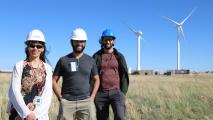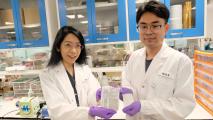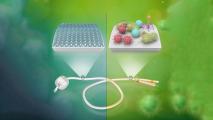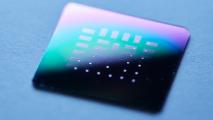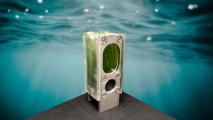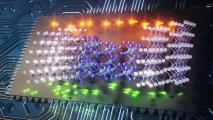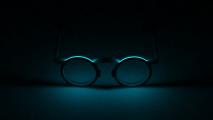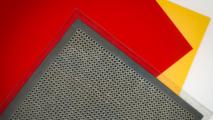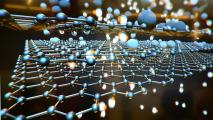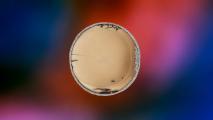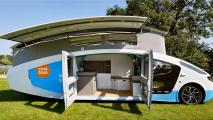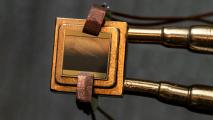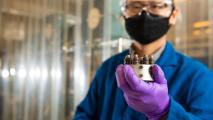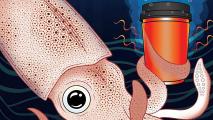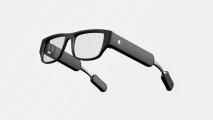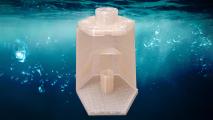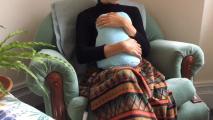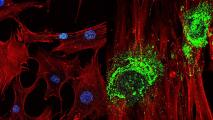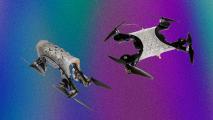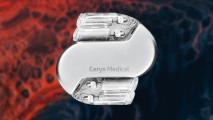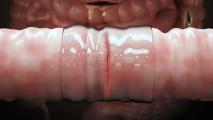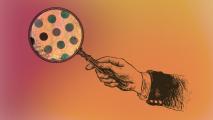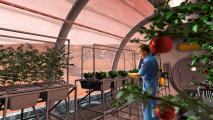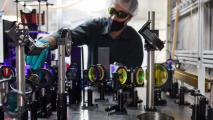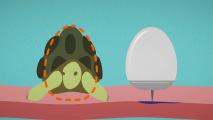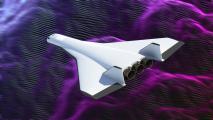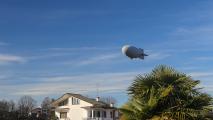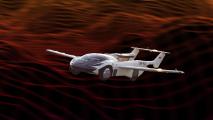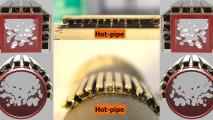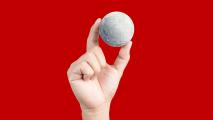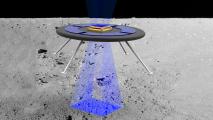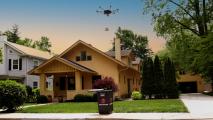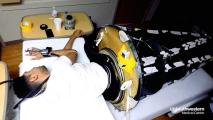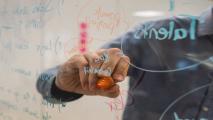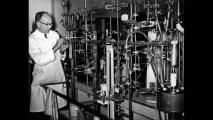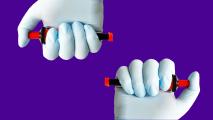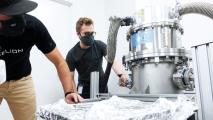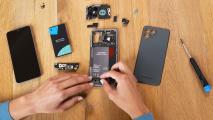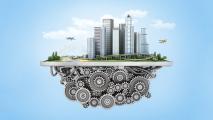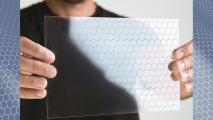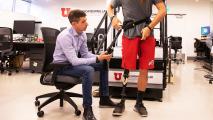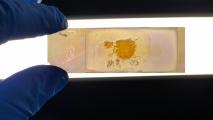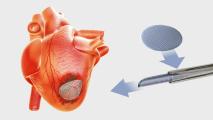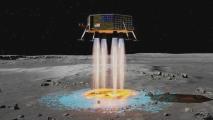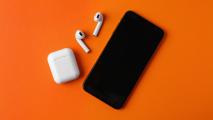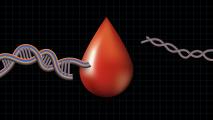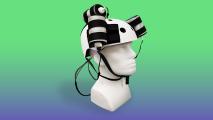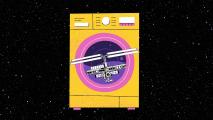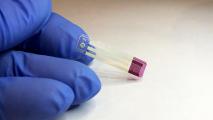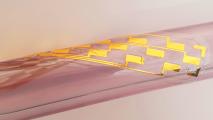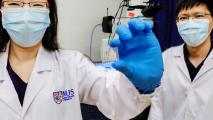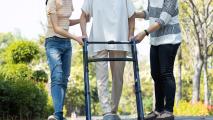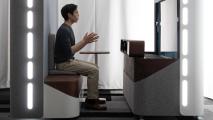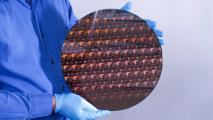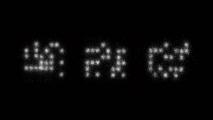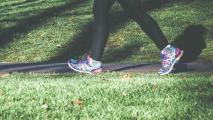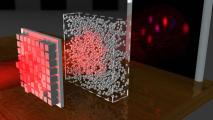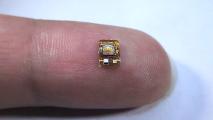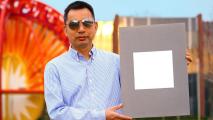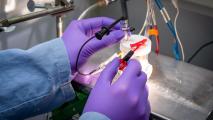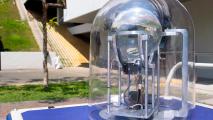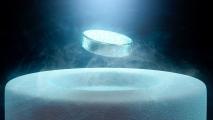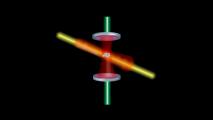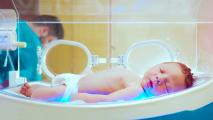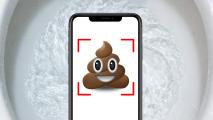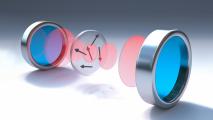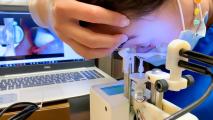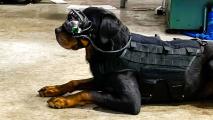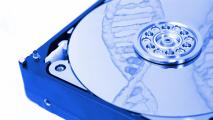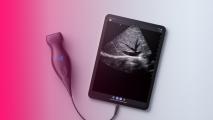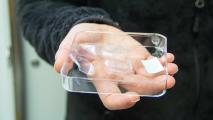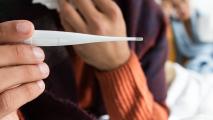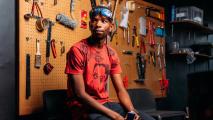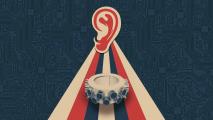Field: Inventions
These bendy wind turbines won’t crack in hurricanes
To significantly scale up offshore wind turbines, SUMR researchers are testing a design inspired by the flexibility of palm trees.
Future tech could 3D print objects inside your body
Direct sound printing could one day allow doctors to build medical implants inside patients’ bodies instead of surgically placing them.
Washable smart fabric turns movement into electricity
NTU Singapore researchers have developed a washable, stretchy smart fabric that turns movement into electricity.
New tech could help prevent 2/3 of hospital-acquired infections
A new treatment could prevent hospital-acquired infections by making it hard for biofilms to form on implanted medical devices.
A new device can make drinking water from seawater at the push of a button
A new portable unit from MIT researchers could make it much easier to remove salt from water to create drinking water.
Elon Musk’s Hyperloop is possible. How badly do we want it?
The Hyperloop is physically possible, but engineering challenges will make its construction difficult. Also, accidents would be catastrophic.
Ultrathin fuel cell uses the body’s own sugar to generate electricity
Batteries have a limit to how small they can be made, and they need to be charged. What if you could power your own medical device?
Algae-powered computer runs for a year on light and water
An algae-powered computer demonstrates a sustainable, reliable way we could power small IoT devices in the future.
Discovery of “impossible” superconductor promises 100x faster electronics
A device that gets electricity to flow through a superconductor in one direction without the use of magnets could revolutionize electronics.
Solar + battery hybrids are poised for explosive growth
Solar panels and battery storage can generate renewable power when solar energy is at its peak during the day and then release it as needed.
Could a former NASA scientist’s “sunlight glasses” protect your vision?
A former NASA scientist has co-developed a pair of glasses designed to prevent myopia by glowing in a precise wavelength of visible light.
Invisibility cloaks are not just possible, but are becoming reality
Two types of nanotechnology, metalenses and metamaterials, could soon make Harry Potter's invisibility cloak a reality.
Researchers develop a paper-thin loudspeaker
The flexible, thin-film device has the potential to make any surface into a low-power, high-quality audio source.
Graphene typically costs $200,000 per ton. Now, scientists can make it from trash.
Graphene is a lattice of carbon atoms arranged in a chicken-wire formation, a structure that makes it very useful for a range of uses.
A new kind of diamond will hold a billion Blu-Ray’s worth of data
Ultra-pure diamond wafers could be used for quantum memory in tomorrow’s ultra-powerful quantum computers.
This solar-powered motorhome was designed by students
Students from the Technical University of Eindhoven in the Netherlands have created a solar-powered motorhome, shaped like a huge teardrop.
MIT’s new heat engine beats a steam turbine in efficiency
A new highly efficient heat engine with no moving parts could allow us to generate electricity from renewables year round.
SpinLaunch to fling a NASA payload toward space
SpinLaunch is going to use a massive centrifuge to accelerate a NASA payload to supersonic speeds before flinging it toward space.
Could you sniff out counterfeit whiskey?
An “electronic nose” that can accurately identify a whiskey’s brand, region, and style could help combat the sale of counterfeit whiskey.
Cheap molten salt battery can store energy for months
A low-cost molten salt battery that can store energy for months could allow us to tap into renewables year round.
Squid skin inspires heat-regulating coffee cup
Inspired by squid skin, UC Irvine engineers have created a cheap, easy-to-recycle material that can be “tuned” to regulate heat.
Nimo smart glasses are like a PC for your eyes
India-based startup Nimo Planet is now accepting reservations for its Nino smart glasses, which let wearers view six virtual screens.
High schoolers create $1 filter to remove lead in water
Maryland high schoolers have created a filter that removes lead in water. It costs just $1 and alerts users when it needs to be replaced.
Swiss scientists are making jet fuel from sunlight and air
The fuel's reliance on sunlight makes desert areas prime land for production sites, leaving valuable agricultural land available for food.
What is 3G and why is it being shut down? An electrical engineer explains
3G networks are built using completely different equipment and algorithms than its newer replacements.
Hugging a cushion that “breathes” can reduce anxiety
A study found that hugging a cushion that “breathes” was able to reduce anxiety for students prior to a test as much as guided meditation.
Sonic waves could help bones grow back after cancer
A technique that turns stem cells into bone cells using only sound waves could help people regrow bone destroyed by disease.
MIT invents $4 solar desalination device
MIT has developed a $4 solar desalination device that could provide a family of four with all the drinking water it needed to survive.
New synthetic tooth enamel is stronger than the natural kind
A synthetic tooth enamel that outperformed the natural kind in strength and durability tests could have applications beyond dentists' offices.
Shape-shifting material morphs robot from driving to flying
A shape-shifting material lets multifunctional robots morph from one shape to the next quickly and without the use of motors.
Bionic pacemaker causes heart to beat irregularly — on purpose
A new bionic pacemaker improved blood flow in animal studies by using the lungs to reintroduce lost heart rate variability.
MIT engineers invent surgical “duct tape”
MIT’s biodegradable surgical tape is designed to seal tears in the gastrointestinal tract, potentially preventing sepsis-causing leaks.
MIT’s new material is stronger than steel and as light as plastic
A new material out of MIT that’s stronger than steel and as light as plastic could one day coat smartphones, hold up bridges, and more.
NASA offers $1 million prize for prototypes to grow space food
NASA’s Deep Space Food Challenge will give away $1 million in exchange for prototypes that could help feed astronauts on long-term missions.
Is metal 3D printing ready for the factory floor?
Metal 3D printing could potentially cut the cost of manufacturing cars, consumer tech, and more — if it can scale.
MIT tests pill to deliver RNA vaccines and therapies
A tortoise-inspired capsule designed by MIT can deliver RNA vaccines and other nucleic acid therapeutics without injections.
Undersea cable laws have hardly changed since 1884 – Tonga shows they need modernizing
Cable-laying ships navigate complex but outdated maritime laws.
New space plane would fly directly into orbit from a runway
Radian Aerospace is building a first-of-its-kind space plane that flies directly into orbit after taking off horizontally from the ground.
Flying “AirCar” cleared for takeoff in the EU
The AirCar — a car-airplane hybrid vehicle with a 600+ mile range — is now officially “airworthy” in the European Union.
Flexible device hugs pipes, turning waste heat into electricity
Penn State researchers have developed a thermoelectric generator that efficiently converts waste heat into electricity.
New biodegradable straws are made by bacteria
New biodegradable straws developed in China are as cheap as plastic, stronger than paper, and made from edible materials.
Clay from kitty litter pulls methane emissions from air
A new technology for reducing methane emissions in the atmosphere relies on zeolite, a cheap, abundant clay found in cat litter.
China builds “artificial moon” on Earth
China’s artificial moon, which uses magnets to mimic lunar gravity, could help with the creation of future moon colonies.
MIT is testing a levitating space rover
MIT engineers have designed a levitating space rover that could allow us to explore parts of the moon that are too rough for rolling rovers.
New smart mailbox is built for drone deliveries
Indiana-based startup DRONEDEK has developed a smart mailbox that can automatically receive and protect goods from delivery drones.
Clever sleeping bag design might save astronauts’ eyesight
A sleeping bag designed for use in microgravity could protect astronauts’ vision by pulling eyeball-deforming fluids away from their brains.
How should we measure innovation?
Researchers have come up with a new method for measuring the impact of an innovation.
7 scientists we are thankful for this Thanksgiving
One of these scientists saved more lives than any other person in history.
How a BBQ lighter can make DNA vaccines more powerful
Georgia Tech researchers turned a BBQ lighter into a delivery system that uses electricity to boost the potency of DNA vaccines.
Powered exoskeletons may be the ultimate fitness machines
Enhanced Robotics is selling a powered exoskeleton to help people achieve their fitness goals, and it doesn’t cost thousands of dollars.
The future of space launches: a giant spinning arm in a vacuum
SpinLaunch has tested a new approach to satellite launches that flings the objects into space, rather than blasting them up with rockets.
Nuclear fusion would change the world. Has its time arrived?
Energy startup Helion claims it will generate electricity from a nuclear fusion device by 2024 — a milestone that could transform the world.
Zero-emission natural gas power plants are coming to US, UK
Net Power has designed a new kind of natural gas power plant that can efficiently capture almost all of the carbon dioxide it generates.
You can repair this sustainable phone yourself
Fairphone’s sustainable phone is easy to repair and contains ethically sourced materials — two major departures from the industry standard.
The world will electrify. This technology can power our sustainable future.
In partnership with Turntide
Attacking climate change requires reimagining our buildings and vehicles as intelligent systems. And it all starts with a smart motor.
5 recent breakthroughs that completely changed electronics
From wearable electronics to microscopic sensors, new advances are bringing "impossible" electronics to life.
New water purification tablet makes river water safe to drink
A new water purification tablet that simply and quickly decontaminates river water could help address global drinking water scarcity.
Robotic exoskeleton gives prosthetic legs a power boost
University of Utah engineers have built a robotic exoskeleton that gives people with prosthetic legs a power boost that makes walking easier.
Smart microscope slides make breast cancer cells leap off screen
Breast cancer cells appear brightly colored when placed on new smart microscope slides, which could help doctors diagnose patients earlier.
New cardiac patch can be implanted with a syringe
A new cardiac patch developed by Canadian scientists could help repair heart damage by supporting tissue without blocking electrical activity.
Spacecraft tech turns moon dust into “near-instant” landing pads
To protect spacecraft from moon dust, Masten Space Systems is developing a tech that quickly creates landing pads on the surface of the moon.
No more cords: one day an entire room may power up all your devices
Charging rooms may free us from the tangle of cords needed to power our electronic devices.
New portable blood test kit is cheap, fast, and accurate
A new blood test kit that’s fast, portable, and accurate could help bring better healthcare to people in remote and underdeveloped areas.
Helmet worn at home shrank man’s brain tumor by a third
A new brain tumor treatment shrank a man’s aggressive glioblastoma tumor by nearly a third — and all he had to do was wear a helmet at home.
NASA interns designed a washing machine for astronauts
NASA challenged its interns to design a washing machine for astronauts so that they wouldn’t have to keep throwing away dirty laundry.
Series|
Just Might Work
How robots could end animal captivity in zoos and marine parks
Could robotic dolphins help marine parks become more humane spaces where people can learn about and connect with nature?
Japan breaks world record for fastest internet speed
Engineers in Japan have set a new world record for fastest internet speed — 319 Tb/s — using a specially developed fiber-optic cable.
The world’s first needle-free diabetes test
A needle-free diabetes test that measures glucose levels from saliva, not blood, could be ready for consumers as soon as 2023.
Hair-thin spine stimulator could relieve severe back pain
A new implant that delivers pain-relieving spinal cord stimulation can be put into place using just a needle — no invasive surgery required.
Blood test can quickly tell if a targeted cancer therapy works
The ExoSCOPE blood test can determine with 95% accuracy whether a targeted cancer therapy is working within 24 hours of administration.
Vibrating “thimble” could improve balance in seniors
A wearable that delivers a painless vibration to a person’s fingertip if it senses postural sway could one day help improve balance in seniors.
These shelf-stable French fries last 90 days at room temp
Startup Farther Farms has developed a pasteurization process that allowed it to create shelf-stable French fries that last 90 days at room temperature.
Google unveils “magic window” for 3D video chat
Google’s Project Starline is a new 3D video chat technology designed to make online communication feel more like real life.
IBM's faster, more powerful microchips
IBM has unveiled the world’s first 2-nanometer microchips, a breakthrough in chip technology that could lead to faster devices that require less energy.
A “Lite-Brite” for DNA data storage
A new method for DNA data storage uses light-emitting strands of DNA to encode digital messages, eliminating the need for sequencing.
Stanford’s ankle exoskeleton lets you walk 40% faster
An ankle exoskeleton that significantly increases self-selected walking speed could make it easier for older people to get around.
Scientists may have found the secret to invisibility
Researchers have developed a unique light wave that, when beamed through an object, makes the object appear invisible to cameras and even the human eye. This could be the key to invisibility.
Implantable oxygen monitor could track deep-lying tumors
An implantable oxygen monitor developed at UC Berkeley could allow doctors to measure oxygen levels deep under patients’ skin.
The world's whitest paint can cool your house — and the Earth
The whitest white paint reflects up to 98.1% of sunlight, which could make it useful for cooling homes in place of energy-hogging air conditioners.
Artificial photosynthesis machine improves itself over time
An artificial photosynthesis device that gets more efficient with time could finally allow us to harness solar energy for uses beyond electricity.
Singapore’s solar concentrator funnels daylight underground
This compact solar concentrator could be the perfect daylight harvesting device for Singapore’s underground spaces.
Electricity transformed the world. Superconductivity could do it all over again.
Scientists are on the hunt for a superconductor that works in higher temperatures and lower pressure.
Therapeutic bed could help prevent brain damage in babies
Calmer is a therapeutic bed for incubators that simulates a caregiver’s breathing and heartbeat to relieve stress in newborns.
New atomic clock is the most precise ever created
MIT researchers have created a new kind of atomic clock that exploits quantum entanglement to keep time more precisely.
At-home breast cancer screening, powered by AI
An award-winning at-home breast cancer screening device, called the Blue Box, could one day replace uncomfortable mammograms.
Reverse engineering a $15k medical device for 50x less
Many hospitals in developing countries can’t access the overpriced, high-tech equipment that’s standard in the U.S. Reverse innovation could finally change that.
Finally! A smart toilet offers fecal testing for the masses
Fecal testing can reveal a surprising amount of medical data. Israeli startup OutSense wants to do so from your home.
Scientists create modem for future quantum internet
Physicists have created a modem for the quantum internet of the future, giving powerful quantum computers a way to share information.
This robot will put your contact lenses in for you
A man in Florida has invented a contact lens robot to insert or extract lenses for people with hand tremors or dexterity issues.
Military dogs may soon sport AR goggles in enemy territory
Military dogs will don augmented reality goggles to test their ability to keep soldiers safe by allowing them to direct the dogs from afar.
All of human knowledge in a tablespoon of DNA
With artificial DNA, a data storage facility as big as a football field could be compressed to the size of a sugar cube.
This magnetic sponge may be the key to oil spill cleanup
A new magnetic sponge makes the job of oil spill cleanup safer for the environment.
Virtual reality meetings are the new Zoom
If you’re sick of video conferencing, you can now access Spatial’s platform for virtual reality meetings for free and without a headset.
This ultrasound connects to an iPhone to help catch COVID-19
Ultrasound can be a useful diagnostic tool for COVID-19. A portable ultrasound machine called the Butterfly iQ may make it safer.
Sending heat to space to reverse global warming
This high-tech material could reverse global warming by using radiative cooling to lower the Earth’s rising temperature.
Forget needles – this thin strip may improve access to vaccinations
Temperature stable vaccinations could change how we store and transport life-saving medicine to the places that need it most.
A smart thermometer is helping fight the coronavirus
Kinsa Health is helping fight the coronavirus by sharing data collected by its smart thermometers as quickly as possible.
Red Bull’s underground pitch competition for young innovators
Red Bull’s pitch competition allows colleges around the world to tap into the limitless potential of young, creative minds to develop new technology for the greater good.
Hey Alexa, quit eavesdropping
Researchers at the University of Chicago have developed an ultrasonic audio jammer that doubles as a fashion accessory.
